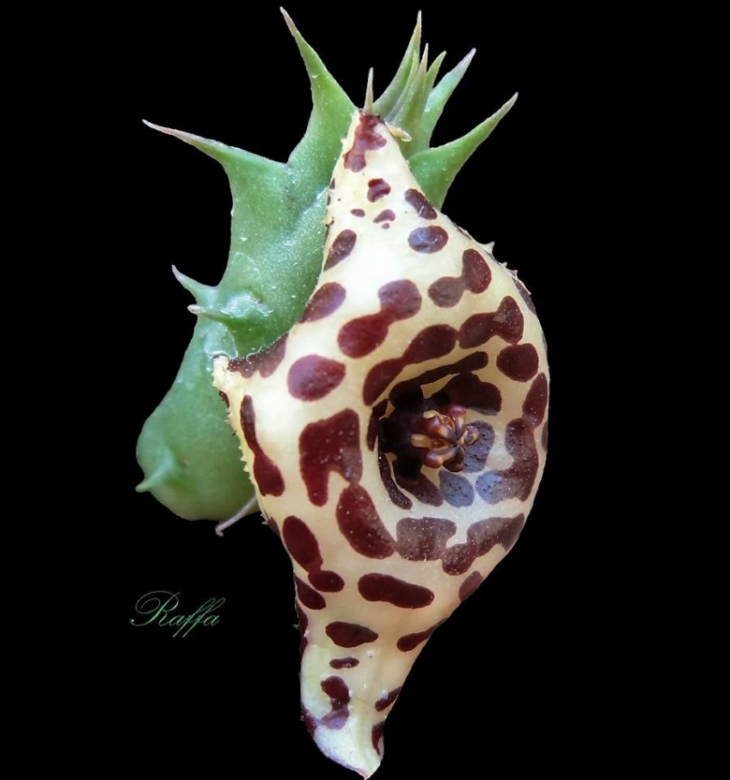




Your support is critical to our success.

Origin and Habitat: Huernia laevisSN|31720]]SN|31720]] was first discovered by J.R.I. Wood in 1979 in the Khowlan Ash Sham district in The Yemen and described in the Kew Bulletin in 1984. It was known only from two small populations until it was found by Sheila Collenette on Jabal Qahar, 85 km. Nth East of Jizzan, Saudi Arabia near the Yemeni border.
Altitude range: 1500-2500 metres above sea level.
Habitat and ecology: This species grows on granitic cliffs.
Synonyms:
- Huernia laevis J.R.I.Wood
Description: Huernia laevisSN|31720]]SN|31720]] is a tufted, perennial succulent distinguished by creamy-white flowers marked all over with small dark red or brownish-crimson spots.
Stems: Lying on the ground but with erect or rising tips, 5-angled, prominently toothed along the angles; teeth 5-6 mm long.
Flowers: The flowers arise in succession from near the base of the stems. Bracts linear about 5 mm long. Sepals very narrowly triangular 10-12 mm long. Corolla about 30 mm in diameter, outside smooth and glabrous, white red- spotted; inside glabrous, smooth and shining, conspicuously marked with irregularly shaped, often elongated, maroon spots and blotches; tube broadly funnel-shaped, ca. 5 mm long, 6-7 mm in diameter., at the mouth; limb lightly convex, with the appearance of an annulus; lobes deltate acuminate, slightly recurved, about 10 long and 8 mm wide; intermediate lobes minute. Corona ± pentagonal, blackish maroon; inner lobes, prominently obtusely gibbous at the base, tapering to a subacute apex, aroung 1,6 mm long, shortly exceeding the anthers but not meeting at the centre. 28136]SN|31720]]; whilst being attractive plants these are hybrids. These are not natural hybrids as the other parent is believed to be Huernia plowesiiSN|31720]]SN|28136]] which comes from Namibia, whilst Huernia laevisSN|31720]]SN|31720]] is found in Yemen.
Bibliography: Major references and further lectures
1) Focke Albers, Ulrich Meve “Illustrated Handbook of Succulent Plants: Asclepiadaceae: Asclepiadaceae” Volume 4 Springer, 2002
2) L. C. Leach “A Revision of Huernia R. Br. (Asclepiadaceae)” Aloe, Cactus and Succulent Society of Zimbabwe, 1988
3) http://www.asclepiad-exhibition.org/Notes_Huernia_l-o.htm
4) J.R.I. Wood in Kew Bull. 39 (1) : 128 (1984).
Cultivation and Propagation: Huernia laevisSN|31720]]SN|31720]] requires moderately watering through the growing season but enjoy plenty of water and some fertiliser in hot weather, this helps them to flower freely. Water more sparingly in winter according to temperatures. But, as with most asclepiads, it is unwise to leave them wet in cold weather.
Frost Tolerance: It is usually recommended to overwinter them in warm conditions (at 10 deg) but they seem to grow well and flower without the extra heat which one might have thought necessary and occasional temperature near 0 deg. are tolerated if kept dry.
Potting medium: Since roots are quite shallow, use a cactus mix or add extra perlite or pumice to regular soil potting soil. A gritty, very free-draining compost is suitable, and clay pots help the plants to dry out between watering.
Pest and diseases: Huernia species vary in their susceptibility to rotting, but are generally fairly easy to grow, especially if kept pest-free. They are very susceptible to stem and root mealy bugs, and damage from these may well initiate fungal attack. If you do have problems with a stem or with basal rotting, you can reliably isolate the healthy parts, dry them off, and re-root them in moist compost.
Propagation: Easiest with stem cuttings. Allow cuttings to dry a day before planting. Stems must be laid (Not buried) on gritty compost and will then root from the underside of the stems. It can also be increased from seeds sowing in spring in moist, sandy peat moss. Barely cover seeds. Seeds germinate quickly.
| Your Actions | |
|---|---|
| Back to Huernia index | |
| Back to Asclepiadaceae index | |
 |
Back to Succulents Encyclopedia index |
Privacy stantement - Terms and conditions - How to cite - About us - Feedback - Donate




